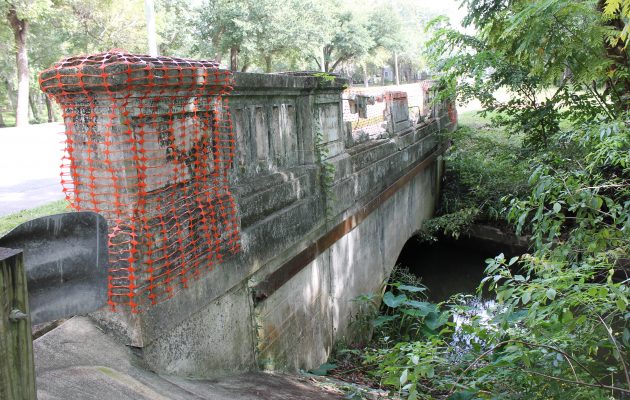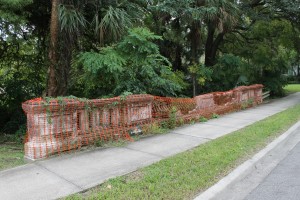Quarter-century wait for culvert replacement
Posted on October 4, 2015 By Editor Articles, Neighborhood News, Top Stories

Although the wheels turn slowly in city government, eventually they do make forward progress. When the year ends, it will also close on the 24th year residents have been waiting for replacement of an arched culvert on Herschel Street that crosses Azalea Creek, also known as Little Fishweir Creek.
A CARE [Citizen Active Response Effort] issue about the culvert under Herschel Street was entered in January 2012; funding for design was approved that May and design started in August, however, it won’t be until sometime in 2016 that the repair project will begin.
Back in 1991, the former Streets and Drainage Department requested that the culvert be replaced, and again in 1998, when Lynn Westbook, division chief at that time, noted that it could collapse if the structure was not replaced.
The cost to replace the culvert in 1998 was estimated at $250,000 with anticipated completion in March 1999. Presently, the estimated cost for the repair is $450,000 and includes replacement of the culvert, cleaning and stabilizing of the channel, new curbs, sidewalks and balustrades.
Built in the 1930s, the culvert has historical significance for Riverside Avondale Preservation. Public Works Department will attempt to match the replacement balustrades to the existing ones, and the work will be coordinated with Riverside Avondale Preservation and the Historic Preservation Committee.
 According to project information provided by James Croft, Public Affairs officer, the Herschel Street culvert running southeast located between Pinegrove Avenue and Van Wert Avenue is failing and the proposed solution is to close the road, remove the failed culvert, and replace it with a precast box culvert.
According to project information provided by James Croft, Public Affairs officer, the Herschel Street culvert running southeast located between Pinegrove Avenue and Van Wert Avenue is failing and the proposed solution is to close the road, remove the failed culvert, and replace it with a precast box culvert.
The assessment notes the current culvert is a corrugated steel plate pipe arch that is partially crushed, held up by a wooden pole at one end. Some of the metal culvert has rusted away. Both headwalls are cracked and are held together by a mounted external steel bar. The roadway shows distress with stress cracks and pothole patches. The roadway has settled along the curbs, creating standing pockets of water. The channel [under the culvert] is choked with debris and sediment.
“The project was at 90 percent design in 2014 when construction funding was requested – but not authorized – in the FY15 CIP [Capital Improvement Projects],” said Croft, in an email to The Resident. “It was one of the many projects reviewed by the Council CIP Subcommittee. The subcommittee has since authorized funding for the project to proceed; it is included in the budget transfer legislation 2015-622 currently in Council.”
By Kate A. Hallock
Resident Community News




 (No Ratings Yet)
(No Ratings Yet)




